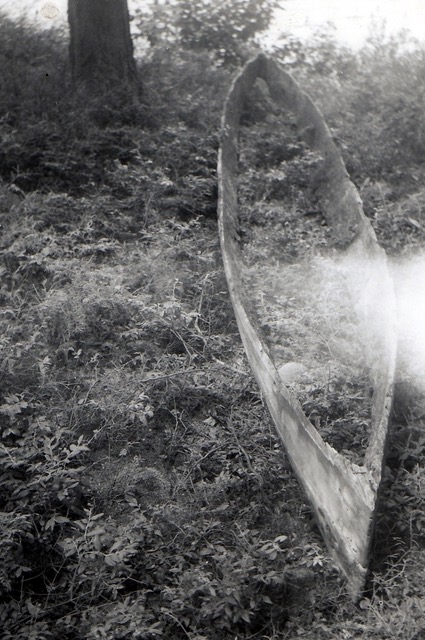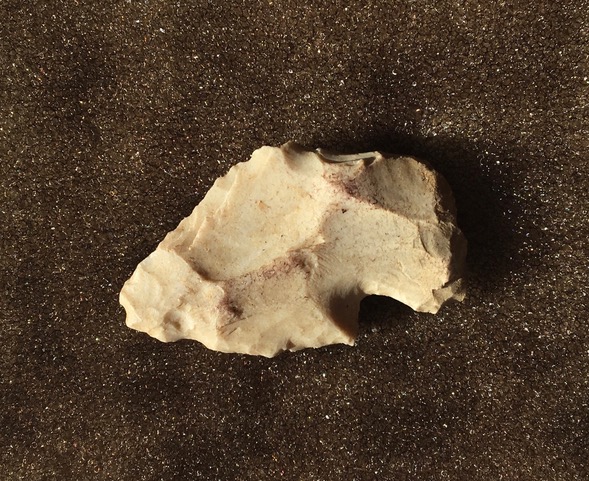Indigenous Peoples in the Bella and Rebecca Lakes Area
While there is currently limited evidence, it is clear that Indigenous peoples have visited our lakes since early times.
Paleo-Indian is a term given to the first peoples who entered, and subsequently inhabited, the Americas during the final glacial episodes of the late Pleistocene period. After the last period of glaciation (11,000 years before present), water levels in Lake Algonquin, which covered much of southern Ontario, were 10 metres higher than today. The Lake Algonquin strand line, or high-water mark, at this time ran mostly north-south and to the east of Highway 11. A spear point found along the Algonquin strand line in the area of the Lake of Bays Inlet (approximately Fairy-Peninsula Lake) was radiocarbon dated to the late Paleo-Indian timeframe.
Glacial spillways and terraces, such as those found along the Big East River, may have attracted Paleo-Indian hunters, as these made a pathway for caribou, while waterways such as Rebecca Creek could have offered transportation routes.
Water levels in the Great Lakes dropped to their current levels about 4,000 to 5,000 years ago, or during the Archaic period. At this time people established camps on or near shorelines and travelled along river and lake routes that are essentially familiar to us today. A Report of the Master Plan of Archaeological Resources of the District Municipality of Muskoka and the Wahta Mohawks notes, “By the late Archaic period almost every lake and river system in north central and northeastern Ontario had been occupied or travelled across.” The report’s model suggests a moderate to high potential for locating evidence of hunting/fishing camps in the vicinity of Rebecca and Bella Lakes.
The report also notes that the development of conservation areas and control dams to maintain lake levels and the continued use of old lumber dams (such as Distress Dam on the Big East River) has flooded sections of land that may contain archaeological resources and artifacts. It has been suggested that the current water levels are, in general, approximately 1.3 metres higher than in the recent past, resulting in the seasonal or permanent inundation of many shoreline sites. However, such changes likely varied throughout the District of Muskoka.
Worked stone artifacts found and dated to the Woodland Period (3,000 BP until European contact, about 1620 CE) are characterized by small, triangular and side-notched projectile points. Such a chert projectile point (approximately 3 cm long) was found near the Bella-Rebecca narrows by Jack Mansell, circa 1936, while he was searching for crayfish. Based on a preliminary assessment by experts, this “arrowhead” is possibly made of chert from southeastern Ohio and could be 2,000 years old (of the Woodland period).
Contact Times
By contact times, and in particular the nineteenth century, present-day Indigenous families based at places like Rama on Lake Couchiching and Beausoleil Island, Georgian Bay, would travel to the Muskoka region (for example, Cedar Narrows on Lake of Bays) in spring to establish gardens as well as to hunt and trap (deer, bear, muskrat, beaver) and trade in the area around their settlements. In the late 1870s, as Henry Field was clearing his building site, he encountered two Ojibwa from Rama who helped him build his shanty. They and their families had set up their camp on nearby Pell Lake for seasonal hunting, fishing, and gathering. A wooden cross at Mizpah Cemetery, engraved “An Indian 1884,” marks the remains of an unknown Indigenous person.
 |
||
| Dugout canoe found in Rebecca Lake (Wendy Kimmel) |
At least four dugout canoes, likely made of basswood or pine, have been found in Rebecca Lake, several filled with rocks and sunk. Were these used by Indigenous peoples or early pioneers? Many instances of both Indigenous and European construction of dugout canoes have been found in Ontario.
In 1934 Thomas Osborne wrote his story of pioneer hardship, The Night the Mice Danced the Quadrille: Five Years in the Backwoods, 60 years after his arrival in Muskoka. In it he describes portaging up to Rebecca and Bella Lakes from Peninsula Lake in order to hunt and fish. Perhaps he was following trails established long before the first European contact.
Sources:
Cooper, Martin, and Andrew Stewart, “A Brief Illustated History of Landscape and Aboriginal Peoples in the Muskoka River Region” (Presentation to Lake of Bays Heritage Foundation, August 2009),
Mansell, W. Dan, and Carolyn Paterson, eds., Pioneer Glimpses from Sinclair Township (Peterborough: asiOsis Natural Heritage Consultants, 2015).
Osborne, Thomas, The Night the Mice Danced the Quadrille: Five Years in the Backwoods (1934); republished as Reluctant Pioneer: How I Survived Five Years in the Canadian Bush (Toronto: Dundurn Press, 2013).
Archaeological Services, Inc., Report of the Master Plan of Archeological Resources of the District Municipality of Muskoka and the Wahta Mohawks, Volume 1: Background Research (February 1994).




